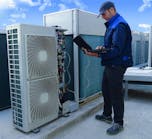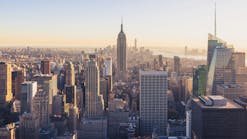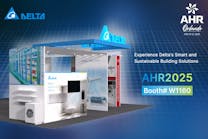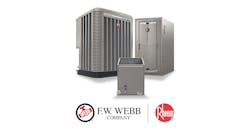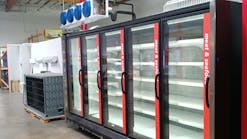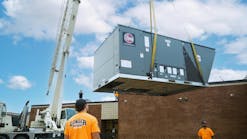The federal government’s increasing activity as a promoter of building air quality and efficiency will continue in 2023. As far as it relates to government-owned buildings, federal government heating and air conditioning projects available to small businesses are numerous and lucrative, as they’ve been in prior years.
The federal government is required by federal law to offer projects to small businesses, women-owned businesses, small/disadvantaged businesses; service-disabled veteran-owned businesses; and HUBzone businesses. And it has billions of dollars to go around.
To meet its annual distribution goals, the government will:
- Set aside contracting opportunities for small businesses only ($15 million or less in annual revenue, on a three-year average;
- Set goals for the use of small subcontractors on large contracts won by large businesses;
- Staff small/disadvantaged business utilization offices in government agencies;
- Dedicate federal resources to helping small businesses work for the federal government.
Speaking during a presentation at the Air Conditioning Contractors Association's 2022 conference and trade show, Dave Kyle, president of Trademasters Service Corp., Lorton, Va., said federal law requires it to reserve 23 percent of trade work in federal buildings for small businesses. This can only continue, because federal buildings must be emission-free by 2050. “It’s a lofty goal, but they’re headed that way, which is good for us,” Kyle said. “They want us to make their buildings better."
How it's Done
Kyle explained that the federal government makes building improvement purchases through a variety of methods:
- Contracting by negotiation: projects valued at $150,000 and higher, requiring highly technical products or services. These are available to a limited pool of contractors, and require a Request for Proposal (RFP), response and negotiations.
- Simplified Acquisition Threshold: for projects less than $150,000, that require less paperwork and the opportunity for many small business set-asides.
- Sealed Bids: these contain very specific requirements; an invitation to bid, sealed bids and evaluation based on specific factors listed in the offer. ”When you see an opportunity for a federal government sealed bid, scan the opportunity, look at its evaluation factors. What are they going to judge you to win on? Sometimes it just the lowest price, Sometimes it’s who's done it before, or who has a very specific method.”
- Micro-purchases, which Kyle said can be the simplest and definitely profitable. These are small projects, up to $2,500, with no competitive bids, no quotes and no procurement officer required. “It’s a great way to get started in government contracting,” Kyle said.
An important requirement is that your HVAC or plumbing business accepts the government credit card. “The federal government is run on credit cards,” Kyle said. “Seventy percent of their purchases are “micro purchases,” which are typically up to $10,000. If the air conditioner breaks and they need to call somebody on the phone just to put a condensor fan motor in, they're going to use their federal impact card to make that purchase.”
Projects in Many Cities
Federal building projects can be found in many US cities. “You probably have something federal near you and you don't even know it,” Kyle suggested. “A post office, Social Security office, or small military base. There’s a never-ending list. The Department of Agriculture has many in the Midwest."
Kyle said acceptance of the federal government credit card is a huge marketing tool to get your foot in the door. “Because, when you show up, and you do what you said you were going to do, in the time you said you were going to do it, and for the amount agreed to, the government sometimes loses their mind, because that's not what they're used to. And they will continue to call you back. Or they'll write an Request for Proposal (RFP) that's very favorable to somebody in the local market.”
Purchases made by the federal government are transacted through “consolidated purchasing vehicles.” The government likes to bundle things and one of those things is the General Service Administration schedule, which is a price list with a contract attached to it. The General Service Administration is the largest landlord for the government. They administer most government owned properties outside of those owned by the Department of Defense.
GSA schedules include:
- GWAC, which are government wide acquisition contracts.
- The Strategic Federal Strategic Sourcing Initiative.
- Building Maintenance and Operation. This wasn’t anything new, it just took a lot of time and reading, but now, we’re one of the few companies in our marketplace, and if they want to go to the BMO schedule, all they have to do is call us. They might compete the work, but sometimes, we show up and there are two or three people in the room, or it might be just Trademasters.
Kyle said 90% of all commercial HVAC businesses are classified as small businesses, and he repeated that the federal government must give 23% of all business to small businesses. “What is shameful is, frequently the people in the mechanical and the built HVAC and plumbing trades don't take the time to do this, so the government ends up going to general contractors, who just come around and flip it to you, and they step on it for a percentage, where you can be the direct person with the government,” he explained.
“And, the small HVAC business can bid on the big contracts, but the big guys can't bid on the small contracts.”
Kyle said there are many opportunities for women-owned small businesses in the skilled trades. “The SBA has a new program called Ascent, that brings education and training to women who want to work in all small businesses, and now just skilled trades, but all small businesses (ascent.sba.gov).
Also, veterans who are business owners, especially service disabled, veteran-owned businesses, have the opportunity to get a subset of that small business set aside. But often, those veteran-owned businesses don’t have enough people to get it done, perhaps because it is a newly formed business, not yet on solid ground. Kyle said an ordinary HVAC or plumbing business could partner with a disabled veteran business to help them achieve their goals. “So it's a total win-win. Also, a veteran owned business can purchase certain property being disposed of by the government, directly from the government.”
Another subset available for special treatment is “socioeconomically-disadvantaged” businesses. “Five percent of all that small business has to go to businesses in that category, and it’s one of the few categories where you can directly negotiate with the federal government without it going out to bid,” Kyle said.
“Hub Zones” are areas of historically underutilized business activity, which the federal government want to assist. Kyle said the government’s trying to set aside 3 percent of the 26 percent for Hub Zones, but are finding it difficult for skilled trades.
Getting Started
1. Determine your business’s NAICS code(s). HVAC and plumbing code is 238220; building construction is 236220; facilities management is 561210.
2. Determine your gross revenues as an average of the last three years, and compare it to your NAICS code. Calculate your gross revenues as an average of the last three years and see if you are small in your NAICS category .
3. Get a DUNS number. This is a unique nine-digit identifier for a business established through Dun & Bradstreet. The requirements are:
a. Legal name
b. Headquarters name and address for the business
c. “Doing Business As (DBA) or other name by which your business is commonly recognized
d. Physical address, city, state and ZIP Code
e. Mailing address
f. Telephone number
g. Contact name and title
h. Number of employees at your physical location
i. Whether it is a home-based business
A form can be found at https://fedgov.dnb.com/webform.
4. Set up an EFT account for Direct Deposit Payments.
5. Consider establishing a bonding program, as some projects require bid bonds and payment and performance bonds.
6. Go to www.sam.gov.
7. Click on “Create User Account.”
8. Follow the instructions to create a login for the system.
Kyle provides the following additional tips related to the registration on www.sam.gov:
Once you have collected the basic business information you need to register and complete the ‘to-do’ list:
- The purpose of your registration is for government contracts, so say “yes” to that question
- Choose all the NAICS codes that may apply because you have to have the NAICS code contracting has selected for any opportunities you are awarded
- You can update your registration any time—changes are immediate or take up to a few days to take affect
- Make sure the remit name and address you enter in SAM.gov exactly matches your invoice
- Make sure your name matches exactly how it appears on your FEIN (the name the IRS has listed for your company
- It may ask for your “cage code,” but if you don’t have one yet, it will be assigned to you after registration)
- Monitor your email and be sure you respond to any emails about your registration
- Remember to update your registration each year
·
